How to Choose a Color Scheme: A Practical Guide to Color Theory

Key Takeaways
Color palette theory will teach you how colors interact and influence perception, enabling you to construct palettes that come across as deliberate, harmonious, and emotionally resonant for digital and print media. Use it to reinforce brand identity and direct user focus.
💫 Discover Your Complete Color Palette
Ready to discover all the colors that make you look radiant? Our comprehensive color analysis will reveal your complete personal palette - perfect for hair, makeup, and wardrobe decisions.
Build My Palette →Study the color vocabulary as you learn relationships like complementary, analogous and triadic. Begin with primary, secondary and tertiary hues, then experiment with groupings on a color wheel to organize your palette.
Combine the psychology of balance with the color palette theory of science, matching emotional objectives with technical precision. You establish the mood you want, and then with RGB or CMYK codes and trustworthy tools, you mix and measure and reproduce colors exactly.
Manipulate hue, saturation, value, and temperature to customize punch and legibility. Build value scales and blend warm and cool, vibrant and muted colors to maintain clarity and interest in your designs.
Be intentional when selecting a scheme by matching colors to your brand, audience, and accessibility requirements. Always test contrast with trusted tools, follow WCAG guidance, and gather user feedback before finalizing.
Think past the screen to culture and physical light. Research color meanings for international audiences, and test samples in various lighting to make sure they translate well on in real world materials.
Color palette theory describes how to use colors in concert to achieve balance, contrast, and mood. It includes hue, value and saturation, in addition palettes such as complementary, analogous, triadic and monochrome.
Painters use it to lead tone and attention. Designers use it to increase readability and brand recognition. Photographers use it to sculpt light and dimensionality.
How to construct robust palettes — begin with a key color, establish contrast, then test readability. The following sections dissect steps, tools and examples.
📚 Recent Articles
What is color palette theory?
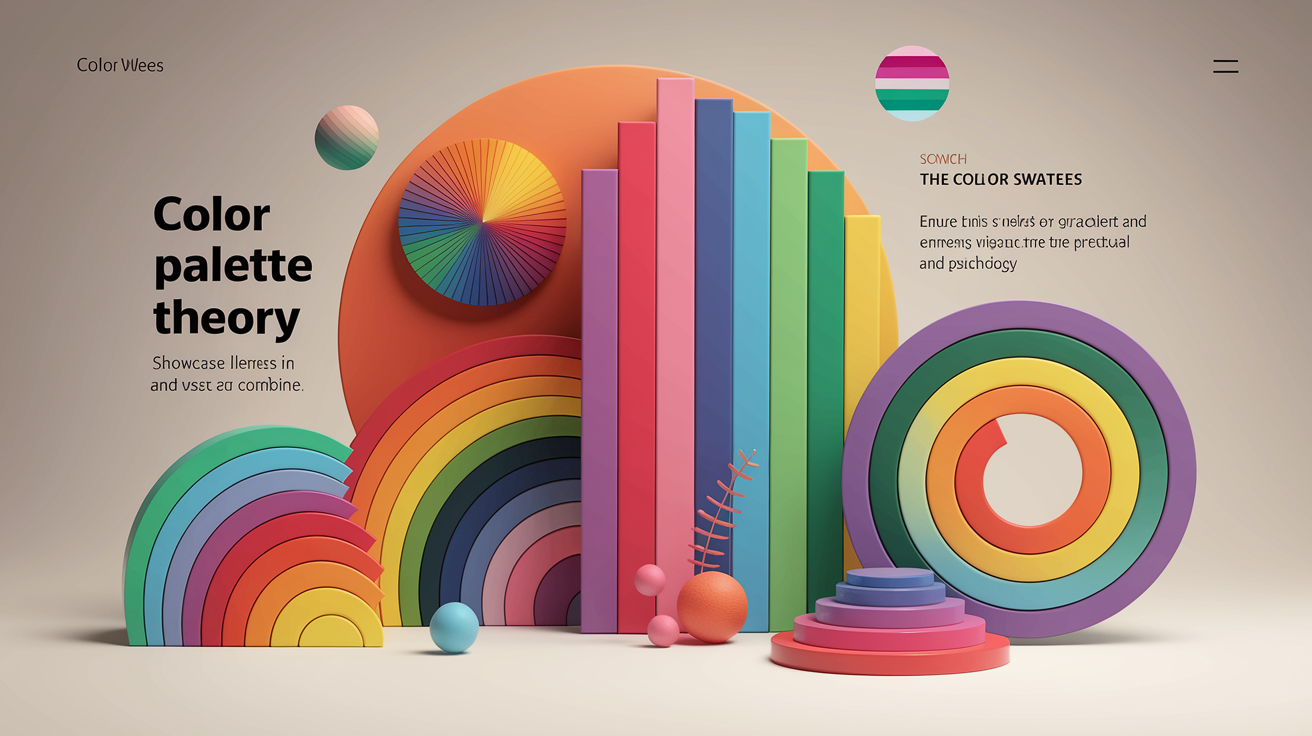
Color palette theory is the exploration of how colors communicate, unite and influence what individuals experience and observe in design. It combines color theory, color psychology, and scientific color models to inform palette selections that are transparent, consistent, and on-brand.
Designers employ it to intentionally pick colors, combine colors, and apply colors — so a design flows, a product seems reliable, and a brand jumps out.
The grammar
Think of color 'grammar' as rules that keep palettes cohesive. It covers how hue, value, and saturation work together. It explains how color temperature (warm, cool, neutral) sets mood and depth and how roles in a palette are assigned: a dominant color for identity, a few accents for emphasis, and a standard text color—often black or gray—for legibility.
Warm colors — yellow, orange, red — come forward. Cool colors move back. Neutrals equalize.
Primary, secondary, and tertiary on the color wheel are the bricks. Primary (red, yellow, blue) mix into secondary (orange, green, purple) while primaries plus secondaries create tertiaries. This wheel is the roadmap for scheme-making.
Associations provide form. Complementary pairs increase contrast. Analogous sets generate flow. Triads balance vigor and stability. Monochromatic schemes soothe and simplify. The correct answer is — it depends on task and audience.
| Scheme | Core idea | Typical effect |
|---|---|---|
| Monochromatic | One hue, shifts in value/saturation | Clean, unified |
| Analogous | Neighboring hues on wheel | Smooth, natural |
| Complementary | Opposites on wheel | High contrast, vivid |
| Triadic | Three evenly spaced hues | Balanced, lively |
The psychology
Color psychology connects colors to mood, action, and brand signals, highlighting the importance of a color scheme in design. Blues tend to feel calm or trustworthy, while reds convey urgency or boldness, and greens evoke a natural or fresh vibe. These emotional cues influence click behavior, quality perception, and dwell time, showcasing how color matters in user experience.
Associations shift based on culture, context, and personal history. A color of good fortune in one culture may serve as a cautionary hue in another. It's essential to test assumptions with your audience—not just your team—using tools like a color palette generator to explore different shades.
Color palettes act as mood and trust guides. Soft neutrals reduce cognitive load, while an accent color can catch the eye and draw attention to a call to action. Pair the emotional aim—security, happiness, concentration—with the palette's warmth and contrast to create a cohesive aesthetic.
Design with purpose: articulate the desired mood in English first, then select colors that support it. Utilizing a complementary color palette can enhance visual interest and strengthen the intended message.
The science
Color models anchor the art. RGB for screens, CMYK and RYB for print and paint. RGB is additive light mixing—combine colors to make white. CMYK and RYB are subtractive—add pigments to absorb light, trending toward dark.
Light, pigment and human vision influence outcome. A saturated blue on backlit glass will not correspond to the same code on matte paper. Control expectations across screens and substrates.
Work with codes and tools for precision. Utilize HEX, RGB, CMYK values, and libraries such as Adobe Color or open source palettes to secure consistency from mockup to handoff.
The color wheel decoded
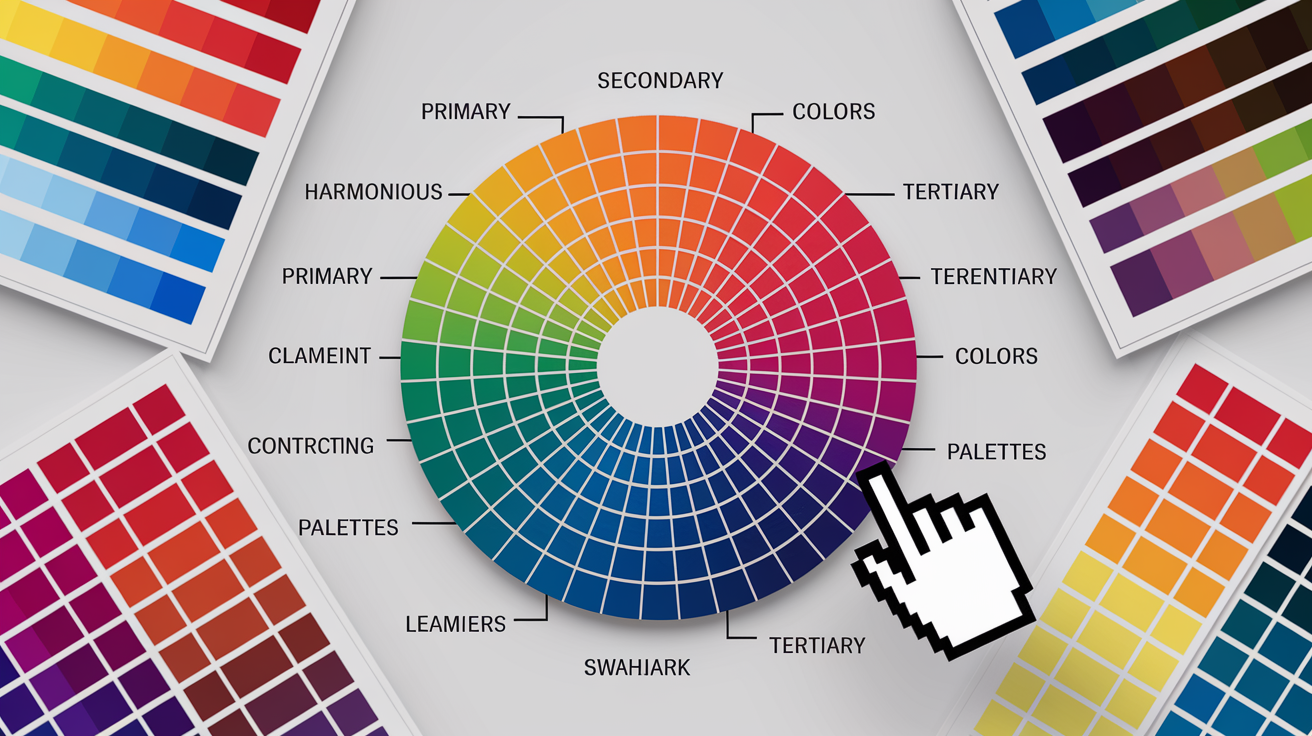
A color wheel is a circular chart of hues that illustrates how colors harmonize and structure, serving as a crucial color guide. It allows you to identify harmony, design contrast, and construct complementary color palettes that translate beautifully on screen and in print. Primary, secondary, and tertiary colors sit around the circle, providing a common vocabulary for blending and coordinating color combinations.
Opposites on the color wheel create strong contrast – complementary pairs face each other, enhancing visual interest. Triadic and tetradic sets space evenly, producing harmonious variety, while monochromatic schemes focus on a single hue and explore its tints, tones, and shades. Designers can experiment with these concepts using an online color scheme generator to observe the results in real time.
From Aristotle to Newton, the wheel has its roots with early thinkers and still guides day-to-day decisions in color theory, helping to achieve effective color relationships.
1. Hue
Hue is the unadulterated color family—red, blue, green—and its positioning on the wheel. It's the name we know it by before we alter it with light or gray.
Hue is not saturation or value. Saturation refers to purity. Value addresses light and dark. Keep those separated in your mind to prevent muddy mixes.
Begin by identifying the primary color for your brand/page/space. If you lead with blue‑green, ground accents around its complements or neighbors. This keeps purpose clear.
Try nearby shifts to widen options: move one step toward blue to cool a summer theme, or one step toward yellow to warm a food app. Tiny shifts alter atmosphere without undoing the dynamic.
2. Saturation
Saturation, or chroma, is the degree to which a color appears pure or intense. High saturation feels brash and raucous. Low saturation feels soft and calm.
Reducing saturation creates more muted palettes that back long-reads and understated UI states. Pushing it up contributes punch for call to actions or sports content.
Mix both for rhythm: a mellow field, a bright cue, then quiet notes. This equilibrium allows eyes to relax and discover what is important.
Sample do a good job. A high‑sat set: electric cyan, hot coral, vivid lime. A low‑sat set: dusty teal, warm clay, mist gray. Both can be transparent if type contrast is adjusted properly.
3. Value
Value is how light or dark a color is, and it is what drives contrast and legibility. Tints add white, shades add black, tones add gray – each move shifts value and changes hierarchy.
Strong value contrast makes text readable, icons clear and charts scannable. Insufficient value contrast obscures structure, even if the hues are different.
Build a simple value ladder per palette: five to seven steps from light to dark, tested on both white and near-black backgrounds. Verify contrast ratios and tweak until edges are clear.
4. Temperature
Color temperature demarcates the warm and cool. Reds, oranges and yellows feel warm, blues, greens and purples feel cool and the wheel displays this division.
Warm shades can come across as intimate, vivid or energetic, while cool ones translate to soothing, aloof or fresh. Use that to establish mood without additional graphics.
Guide attention with temperature shifts: cool base, warm focal buttons; warm hero image, cool navigation. That contrast is what pulls the eye.
Warm & cool, mix for balance. A cool slate with a warm amber accent, or a warm sand with a cool teal note, adds dimension without fuss.
Why color harmony matters
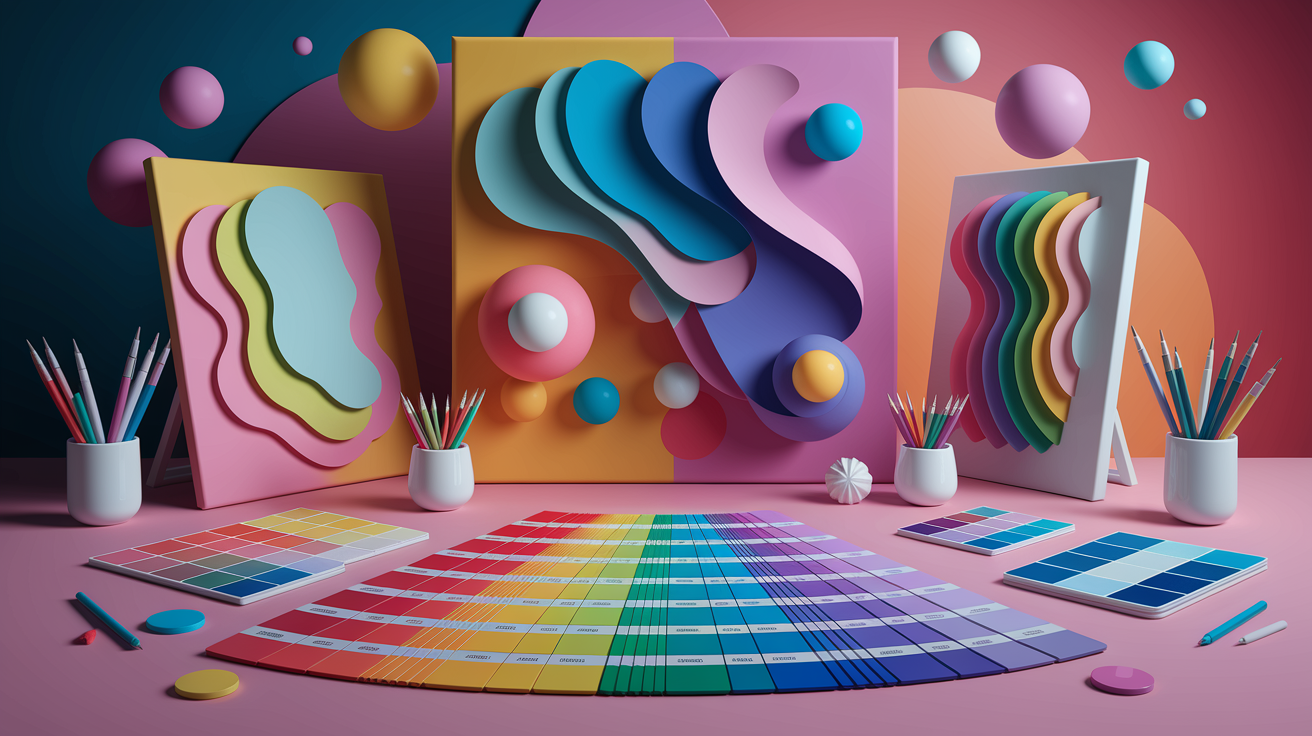
Color harmony pulls a design together, creating a refined and serene visual experience. When your colors are in harmony, the entire piece reads as one voice, resulting in a considered and credible aesthetic that most brands and teams crave. This is where a complementary color palette can enhance the overall effect, ensuring that the colors work well together to create a cohesive look.
Harmony backs up brand identity by establishing a consistent visual mood throughout touchpoints. For instance, a bank that relies on cool blues and neutrals exudes calm and order, while a sport label that couples deep black with a lime sharp suggests speed and edge. By maintaining these color choices, people start to recognize the brand quickly, from app to ad to box on a shelf, reinforcing the importance of a well-defined color scheme.
This is more than style; color can influence decisions significantly. Many consumers make their initial purchase decisions based on color, and research shows that color can influence over 50% of purchase or rejection choices. When the chosen color combinations suit the promise of the product, trust and confidence in the brand increase.
On screens, harmony directs where to look first and then next. Use an obvious dominant color for the majority of the space, a supporting color to provide the structure, and a tiny highlighting color to draw the eye to important actions. The 60-30-10 rule helps: 60% base (say, soft gray), 30% support (navy), 10% accent (teal) to mark links or calls to action.
In print, the same logic keeps spreads clean and engaging: a warm neutral for background, a cooler tone for type or charts, and a bright note for data points. This is how color facilitates flow and reduces fatigue, making it essential for maintaining visual interest.
Bad balance does the opposite. Clashing hues or equal-weight colors duke it out for attention, create noise, and repel people. Red type on ultramarine, or vibrant green on black, can be difficult to read. For accessibility – test contrast ratios and don't use color-only signaling.
Adding labels, patterns, or icons ensures that individuals with low vision or color blindness still receive important information. Strive for strong contrast between text and background colors, and check with popular tools to ensure accessibility standards are met.
Emotion lies at the heart of color choices. Colors carry mood: cool tones calm, warm tones energize, muted tones signal quiet, and loud tones spark action. Meanings can vary by culture, making context vital. For example, white may represent purity in one culture but signify grief in another, illustrating the need for a thoughtful color guide.
For international work, look into the target market and test with local users. Two paths to harmony help: similarities and contrasts. Matching colors (teal, blue and navy) have parts in common and feel sleek.
Contrasts (like orange and blue) contrast in light and saturation and provide punch. With the color wheel plot these ties across your primary, secondary, and tertiary shades. Balance both for depth and focus.
Formulas for creating palettes
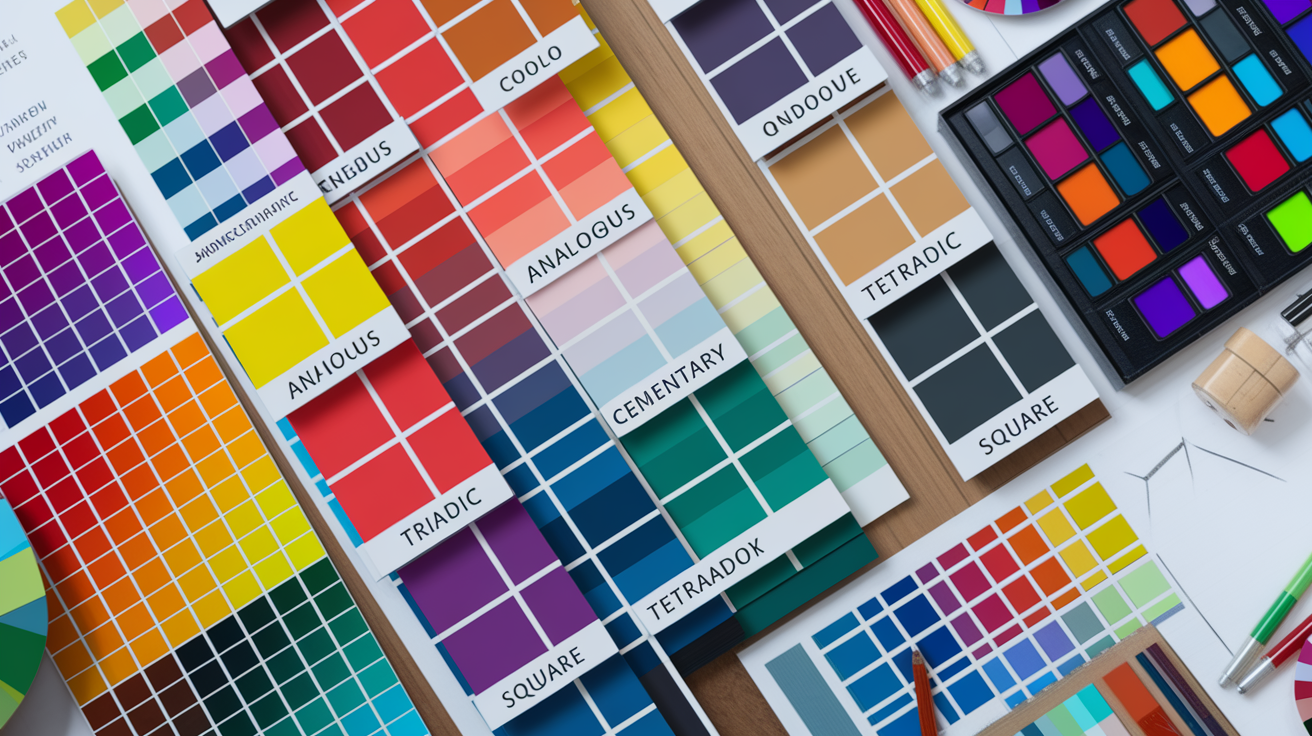
Color palette theory relies on repeatable formulas, which create balance, contrast, and mood in unique ways. Color wheels and palette generators help ui designers test options quickly. Save your selections, jot down ratios, and reserve one text color (black or grey) for readability. A practical color scheme often holds six colors: one dominant, four accents, and a neutral text.
Monochromatic
Monochromatic palettes are one hue with only the tints, shades and tones shifted. You fix Saturation and Brightness, and shift Hue for other swatches only if you desire small increments. For a hard core mono set, keep the Hue constant and vary lightness and saturation. The outcome is understated, serene and effortless to maintain.
They serve minimalist/focused design well, where content has to have the stage. Designers like them because harmony is inherent and contrast comes from light–dark steps, texture, and scale.
- Deep blue base: navy (primary), steel blue, sky blue, mist.
- Emerald base: forest, emerald, jade, pale mint.
- Ruby base: burgundy, ruby, rose, blush.
- Charcoal base: near-black, graphite, slate, ash.
Analogous
Analogous palettes collect neighbors on the wheel, usually three. They just seem organic and cohesive, as if they were a slow natural gradient. Awesome for soothing pages, product ui, longreads.
- Teal–Green–Lime: cool to fresh, good for wellness and eco apps. So teal stays dominant, lime as tiny pop.
- Orange–Amber–Gold: warm and friendly, strong in food or travel; balance with soft neutrals to avoid glare.
- Violet–Indigo–Blue: quiet and cerebral, blue for base, lean on it, add violet for lights.
- Red–Vermilion–Orange: energetic, suits sport or alerts; cap saturation to reduce fatigue.
The secret is contrast control. Shift value (light/dark) and saturation within the trio to escape a flat wash.
Complementary
Complementary pairs occupy opposing positions on the wheel—blue/orange, red/green, purple/yellow. They add high contrast and immediate focus, perfect for CTAs or data points.
Just choose one color as your dominant field and the other as your accent. Overuse causes eye fatigue, so mute one edge, reduce saturation or include a buffer neutral. Do your best to make text readable & pass contrast checks.
For jewel tones, a safe saturation range is 73–83 and brightness 56–76, which maintains richness without glare.
Triadic
Triadic sets space three colors evenly around the wheel. They contain contrast and harmony simultaneously, so they are suitable for brands, dashboards, and editorial content. One dominant, two accents – a crisp approach for constructing a six-color palette with neutrals and a typical text gray.
Popular triads:
- Red–Yellow–Blue (classic, bold).
- Orange–Green–Purple (playful, modern).
- Teal–Magenta–Lime (fresh, tech).
- Navy–Rust–Olive (muted, mature).
Begin from one swatch, establish Saturation and Brightness, then adjust the other two for crisp contrast, no noise.
How to choose a color scheme
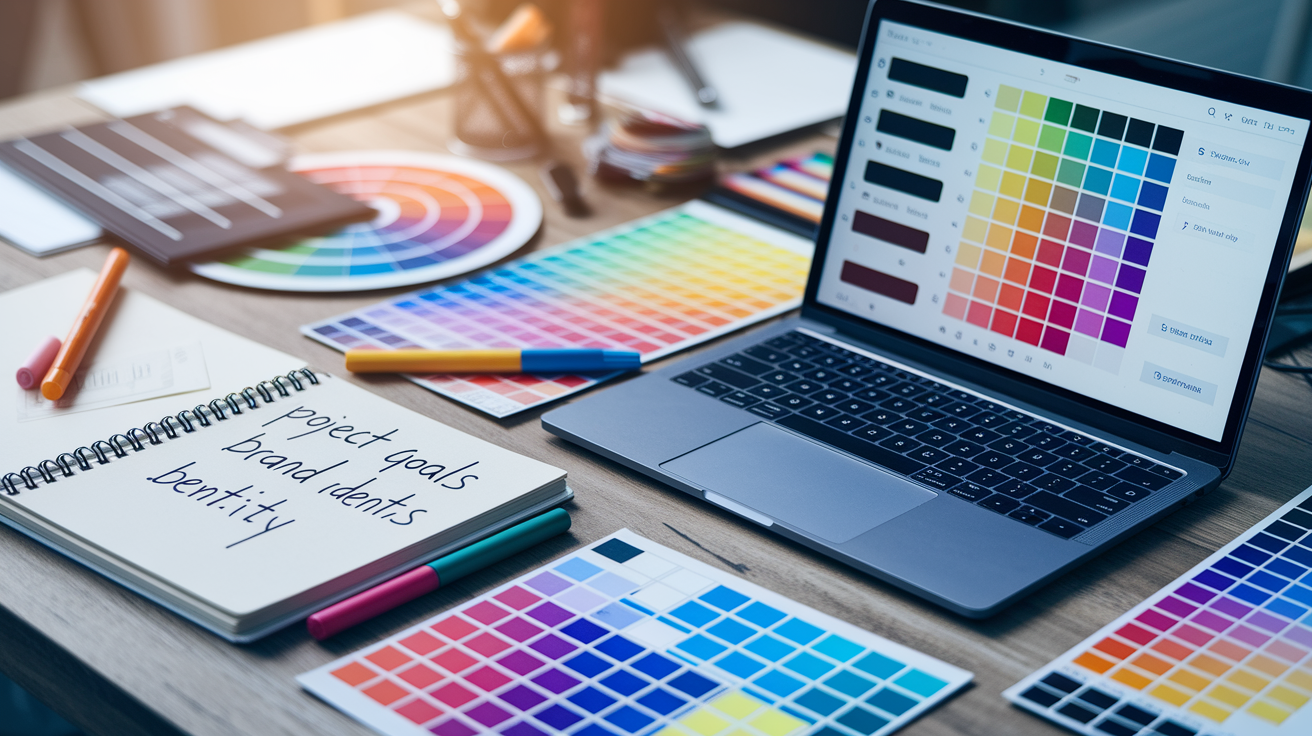
Make choices that align with your goals, brand, and audience by starting with an anchor color. Then, construct accent colors and neutrals while utilizing a color palette generator to explore complementary color palettes for better contrast, accessibility, and emotional appropriateness.
Define purpose
Define the message, mood and work your colors must accomplish. Warm reds and oranges can propel energy or urgency. Cool blues and greens may indicate calm or trust. If clarity is the objective, fall back on high contrast and a limited palette.
If you care for delight, let accent pops dance on clean canvas-like grounds. Note where the palette will live: web, print, product, or ads. Web and app interfaces require bold contrast and scalable tokens. Print requires CMYK-safe options and proofing.
For campaigns, modify the same core set across formats. Make clear, measurable goals such as increase readability, increase click-through, or direct attention to a call to action. Document the intent and write a few rules: main hue, accent use, neutral range, and examples.
This maintains team alignment when the work scales.
Understand audience
Investigate the individuals who will view and utilize the design. Age can alter contrast requirements and color preference. Younger users might like bright triadic sets, older users tend to favor calmer ranges with more distinct value steps.
Think about gender mix, region and cultural connections to color. Blue tends to read as trustworthy in most cultures, while white can mean either purity or mourning. Give background when stakes are high, and don't assume.
Personalize the palette to meet expectations. For finance, a cool, muted scheme likely to build trust. For a game, similar brights can come across as energetic. Validate with quick tests: ask users to rank feelings, check task success, and invite comments.
Test contrast
Readability and access come first in digital work. Verify text/background combos with contrast checkers to achieve WCAG goals. Tune value, saturation or hue until edges are crisp. Pushing a tint lighter or a shade darker typically cures fatigue quick.
Select three to four colors. Don't forget to add at least one tint, normal and shade to maintain depth. A monochrome route works too: one hue, then mix tints, shades, and tones.
The color wheel assists you in mapping analogous soothing or triadic equilibrium, and a primary selection grounds palette as you include variations.
Checklist for testing:
- Map roles: primary, secondary, accent, neutral.
- Run contrast ratios for all text sizes and states.
- Prototype key screens; swap pairs that fail.
- Use a color picker and click and drag opacity to fine tune layers.
- Recheck on light/dark modes and different displays.
- Gather feedback, iterate, and log changes.
Color beyond the screen
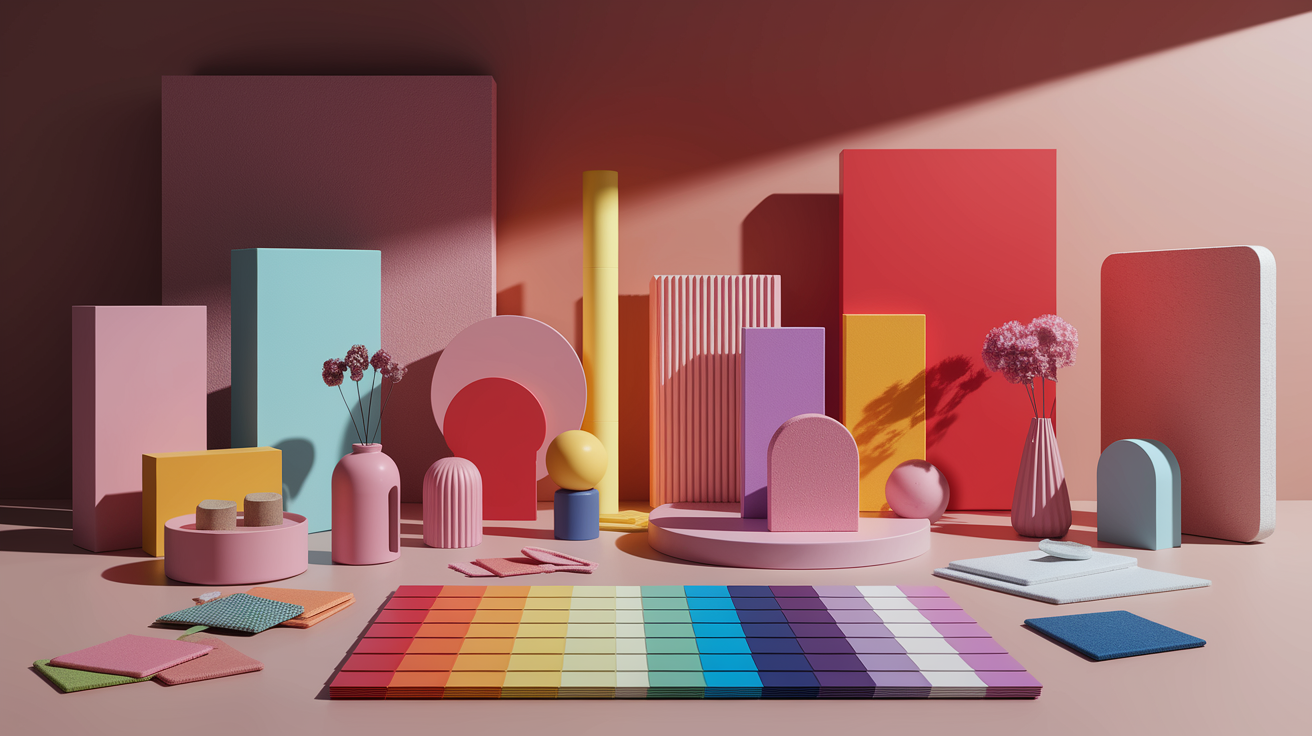
Color, not just on the screen, plays a vital role in aesthetics and brand trust. Understanding color theory, including complementary color palettes and color associations, enhances how colors resonate and influence mood.
Cultural context
Color has a different significance in other cultures. A shade that indicates fortune in one place might indicate mourning in another. We bring personal histories as well, so that same blue might soothe someone and disturb someone else.
In film and visual storytelling, teams rely on these cues to cue fear with red, serenity with pale blue, or tension via color dissonance. The same strategy can inform packaging and store design as well, but always after local oversight.
To avoid slip-ups, studies should cross academic sources, local brand teams, and user interviews. Make a short brief: regions, key hues, taboos, and preferred contrasts. Maintain context notes — since significance changes by event, not only by nation.
Reference table (high-level, not exhaustive):
- Red: East Asia—luck, celebration; Western Europe/North America — passion, peril; South Africa—mourning
- White: North America/Europe—purity, simplicity; East Asia—mourning (sometimes); International tech—pristine, uncluttered
- Black: Global luxury—premium, formal; Many regions—mourning; Fashion—elegance
- Green: Middle East—reverence (contextual); Global eco—nature, safety; Finance—growth
- Yellow: South/Southeast Asia—joy, sacred (contextual); Europe—caution; Global—energy, warmth
- Purple: Europe/North America—royal, creative; Latin America—mourning (in some areas)
Physical light
Just noon daylight can chill a palate; golden hour bakes it; fluorescent lamps can shine green; some LEDs bleed blue or magenta. Texture and finish are just as important as shade.
A matte paint diffuses, lessening glare. Glossy varnish enhances saturation but might warp under spotlights. On coated paper, it enhances contrast; uncoated paper absorbs ink and mutes detail.
Test swatches on location. Switch samples between sun, 2700 K & 4000 K LEDs and store fluorescent. Photograph and record the delta E if you deal in measured color. Observe how rough cardboard mutes a brand orange compared to how the same ink pops on foil.
In converting a digital palette, designate Pantone or CIELAB targets, define acceptable tolerances and lock a light spec for sample rooms. Capture it. Add retail lighting diagrams, event fixtures and color temperature, print run proofing notes.
Post before/after shots so teams see the shift, not just read about it.
Digital accessibility
Color continues to convey feeling and significance, but it has to remain legible. A lot of users see color differently, so steer clear from red/green and blue/purple pairs for key states.
Employ WCAG-ratio-hitting high-contrast combos. Couple hue with text labels/icons/patterns for errors, alerts and charts. Check palettes with protanopia, deuteranopia, and tritanopia simulators.
Run contrast checkers on body text, UI controls, infographics. Construct a token palette with semantic labels — success, warning, info — so teams can exchange colors without shattering significance.
Save some jarringly contrasting choices for accents, but keep them to limited expanses and key moments.
Conclusion
To select a powerful palette, trust the chart, not the chatter. Paths are made clear by the wheel. Harmony keeps eyes easeful. Contrast directs attention. Small twists change mood quickly.
Remember the objective. A shop needs trust? Opt for cool blues with a warm accent. Food brand needs zing? Experiment with vibrant reds against crisp greens. A data chart should have very clear read. Utilize high contrast, and be restrictive on hues — 3–5. Try colors on light and dark. Check phone and laptop. Swap one shade if it competes with the text. Small shifts solve large hurt.
Time to construct your next color palette. Experiment with one formula today. Dump the swatches. Spread the word to a pal. Grab notes fast. Then ship your color story.
Frequently Asked Questions
What is color palette theory?
It directs the choosing of harmonious hues. Designers employ it to form balance, contrast, and mood. It pulls from the color wheel, harmony rules, and psychologies.
How does the color wheel help me choose colors?
Color wheel maps hue relationships, showcasing complementary color palettes, analogous colors, and triadic color schemes. Use it to temper contrast and enhance visual interest across initiatives.
Why is color harmony important?
Color harmony establishes visual order through effective color schemes. Harmonious palettes, including complementary color palettes, minimize strain and maximize readability, encouraging brand recognition and user trust.
What are common formulas for building palettes?
Common formulas include complementary color palettes, split-complementary, analogous color schemes, triadic, and tetradic. Each offers a unique balance of contrast and harmony. Start with a base shade and use a color scheme generator to select complementary colors.
How do I choose a color scheme for my brand?
Begin with your brand values and target audience. Choose a primary color that embodies your message while incorporating a complementary color palette for visual interest and versatility. Ensure accessibility and contrast in both print and digital formats.
How can I ensure color accessibility?
Verify contrast ratios using tools such as WCAG contrast checkers to ensure visual experience meets standards. Aim for a ratio of 4.5:1 for body text and consider using complementary color palettes for effective communication.
Do colors behave differently in print and on screens?
Yes. Screens utilize the additive color model with RGB light, while print employs the subtractive color model with CMYK ink. Understanding color relationships is essential, so always convert and check values prior to final production!